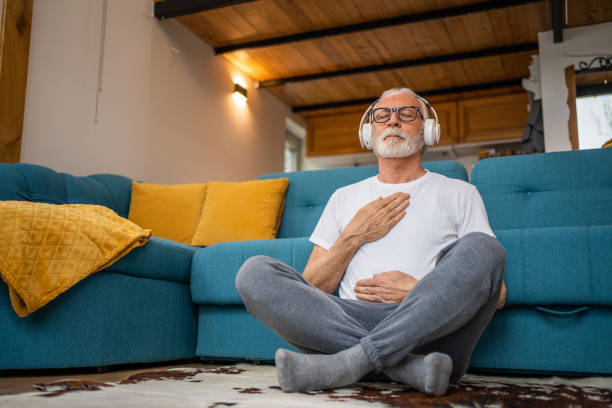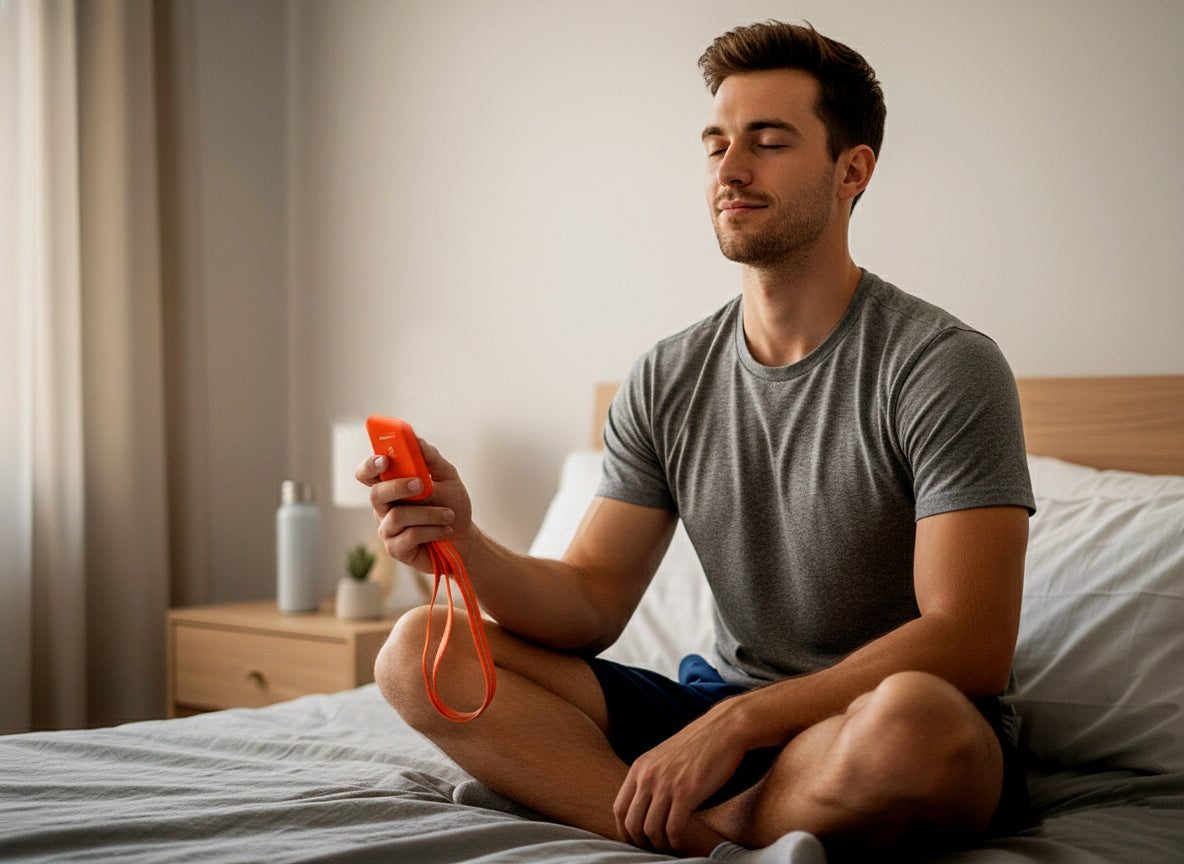

Understanding the issues of breathing
Breathing influences cardiac coherence by modulating heart rate variability, crucial for cardiovascular homeostasis and emotional regulation. It regulates heart rate, playing a key role in the response to stress and anxiety.
A controlled breathing rhythm promotes better quality sleep by optimizing physiological recovery processes. In addition, adequate breathing supports physical performance by increasing muscle oxygenation and improving the ability to adapt to sustained physical efforts.
Functioning

1.Prepare your Relaxation Space
Find a Comfortable Position
Hold the Pneemo 2 Atemtrainer in your hand. Its ergonomic and minimalist design fits naturally into your palm, providing an instant sense of calm and focus.
Whether before a meeting, after a workout, or in the evening to unwind, this simple gesture becomes a ritual of regeneration.
Each time you hold it is a promise — to regain control, simply by breathing.

2. Start Your Pneemo 2 Atemtrainer
Let Science Breathe for You
A single press on the top button activates the preprogrammed 4/6 breathing cycle:
4 seconds of inhalation, 6 seconds of exhalation.
This precise rhythm, derived from research on cardiac coherence, synchronizes your breathing with your autonomic nervous system.
Each vibration is a cue: inhale during the pause, exhale during the vibration.
Within seconds, your body understands. You transition from stress to serenity — effortlessly.

3. Respiratory Synchronization
Activation of the Autonomic Nervous System
Let yourself be guided by the device’s rhythm.
The gentle vibrations create a direct connection between your breathing and your autonomic nervous system.
Your heart rate stabilizes, your mind calms, and your thoughts align.
It’s no longer an exercise — it’s a sensation.
The Pneemo 2 Atemtrainer becomes your inner metronome — a guide to calm and control.

4. Box Breathing Mode
The Breathing Technique of Elite Athletes
Need clarity before an effort, a presentation, or a workout?
Press the top button four times for 2 seconds to activate Box Breathing mode.
Each phase lasts 4 seconds: Inhale / Hold / Exhale / Hold.
The rhythm changes — alternating oscillating vibrations, pauses, and continuous pulses.
This “square breathing” method, used by pilots, athletes, and special forces, enhances focus and mental stability.
After a few cycles, your attention sharpens — calm, clear, and controlled.

5. Personalization & Reset
Your Rhythm, Made Simple
Every individual has their own breathing tempo.The Pneemo 2 Atemtrainer allows you to adjust inhalation and exhalation times to match your physiology or current state.A simple combination of the IN and OUT buttons saves your preferred rhythm — a vibration and a tone confirm the setting.At any time, you can return to the default 4/6 cycle by pressing both buttons simultaneously.A vibration and a yellow indicator light confirm the reset.
Testimonials from our users
I can no longer do without pneemo for a quality night's sleep. It has become an essential part of my bedtime routine.
— Nicolas Albart
I desperately searched for a solution to control my condition without resorting to medication. That's when I discovered pneemo, and it was a real eye-opener for me.
— P. Kursner
I noticed that by using pneemo, I am better equipped to deal with stress and I feel more balanced overall...
— Hugues Fontaine
FAQs
Why does Pneemo® use a 4-6 breathing rate?
Much research has been done on breathing rates, and many studies agree that a longer exhale is more beneficial. The pneumogastric nerve is a complex of cranial nerves which, among other things, functions to relay relaxation from the central nervous system to the body. The activity of the pneumogastric nerve is modulated by respiration, which is suppressed during inspiration and activated during expiration. Prolonged exhalation therefore results in a relaxation signal through the pneumogastric nerve, which in turn leads to increased activity of the pneumogastric nerve and further relaxation.
This explains why exhalation is longer than inhalation, but why 4-6 specifically?
The typical respiratory rate of a normal adult is 12-15 breaths per minute. Reducing this rate to just 6 breaths per minute through slow-paced breathing (which is achieved with Pneemo®’s 4-6 pace), has been shown to maximize heart rate variability (HRV). This is an important effect, as reduced HRV is closely associated with a number of stress-related disorders.
Can't I just count?
In theory, yes. But your counting is unlikely to be as accurate as the rhythm precisely programmed by Pneemo®. Plus, when you are stressed or panicked, having to rely on yourself to regulate your breathing is an added pressure and contradictory to the practice of slow-paced breathing. Let Pneemo® do the work for you so you can focus solely on inhaling and exhaling to regain calm and control.
My phone has an app - is this the same thing?
No, it’s not quite the same thing. While it can help regulate your breathing, pneemo® is quicker and more easily accessible in an emergency. Speed is imperative, especially in the event of an anxiety, panic and fear attack. Hyperventilation is often the precursor to these attacks, so it’s important to be able to regain control as quickly as possible and pneemo® is the fastest way to do this. Additionally, the vibrations of a cell phone are often perceived as an alert or alarm, which is counterintuitive to the calming effect of slow breathing. Using pneemo® to regulate your breathing is the quickest and calmest way to regain control.
Can my child use it safely?
Not only is it safe, but it is encouraged for children with anxiety disorders, ADHD, and behavioral issues.
How long should I breathe with Pneemo®?
As long as you need it to feel safe. You know your body best and once you become familiar with Pneemo® you will know how long it takes for you to reach calm. Research indicates that this is usually between 3 and 10 minutes, but Pneemo® will continue its rhythm for up to 15 minutes before automatically stopping (although you can stop it earlier if necessary)
My grandmother is blind. Can she use it?
Absolutely. Pneemo® can be worn around the neck thanks to its beautiful Swiss-made ribbon. We designed it this way to allow quick and easy access in case of emergency. Once your grandmother has learned where the power button is, she will easily be able to activate the rhythm of Pneemo® and the vibrations will tell her to inhale and exhale. This also applies to anyone with hearing problems and that is why we describe Pneemo® as your safety blanket and companion. It is portable, reliable and can be used by anyone, anywhere.

